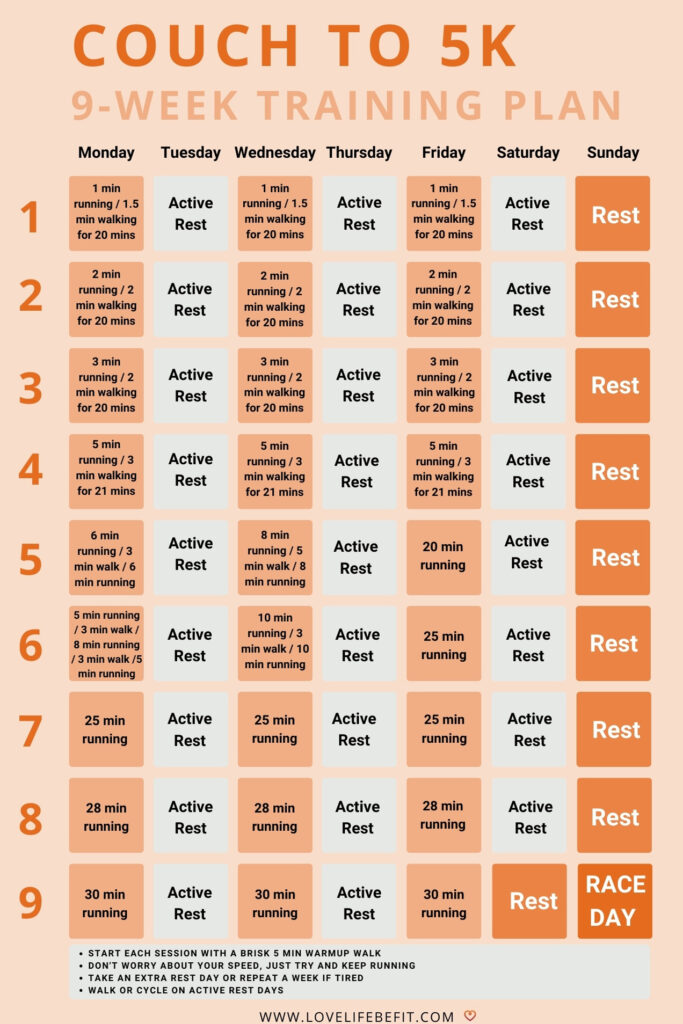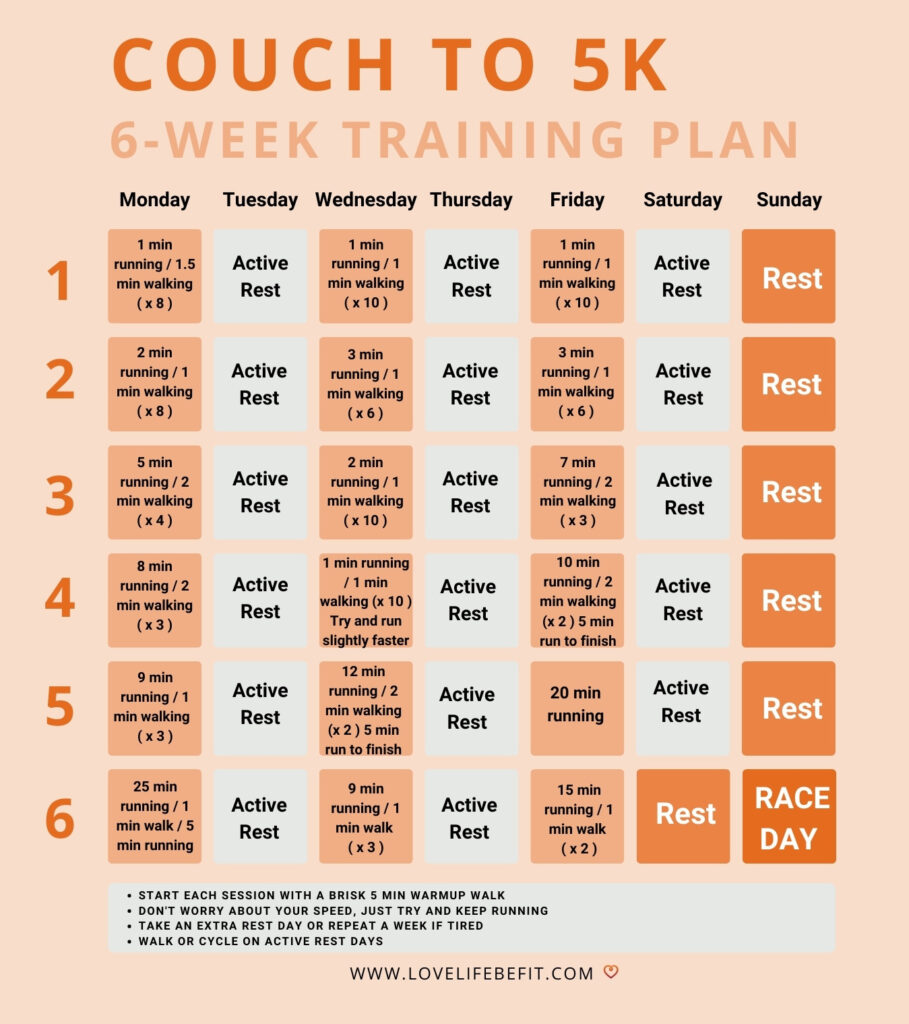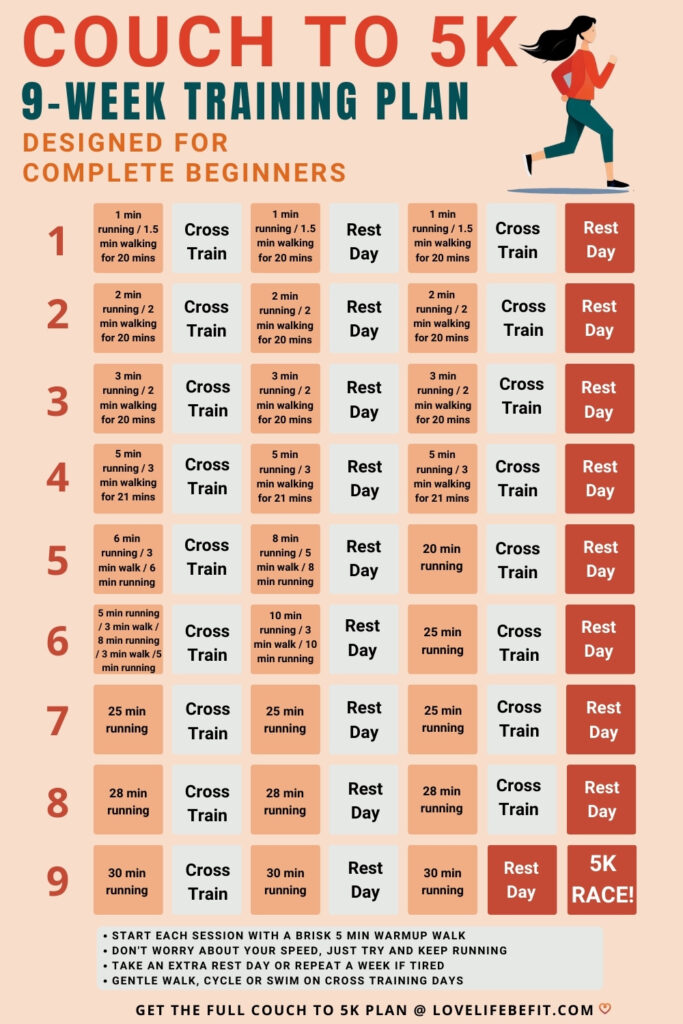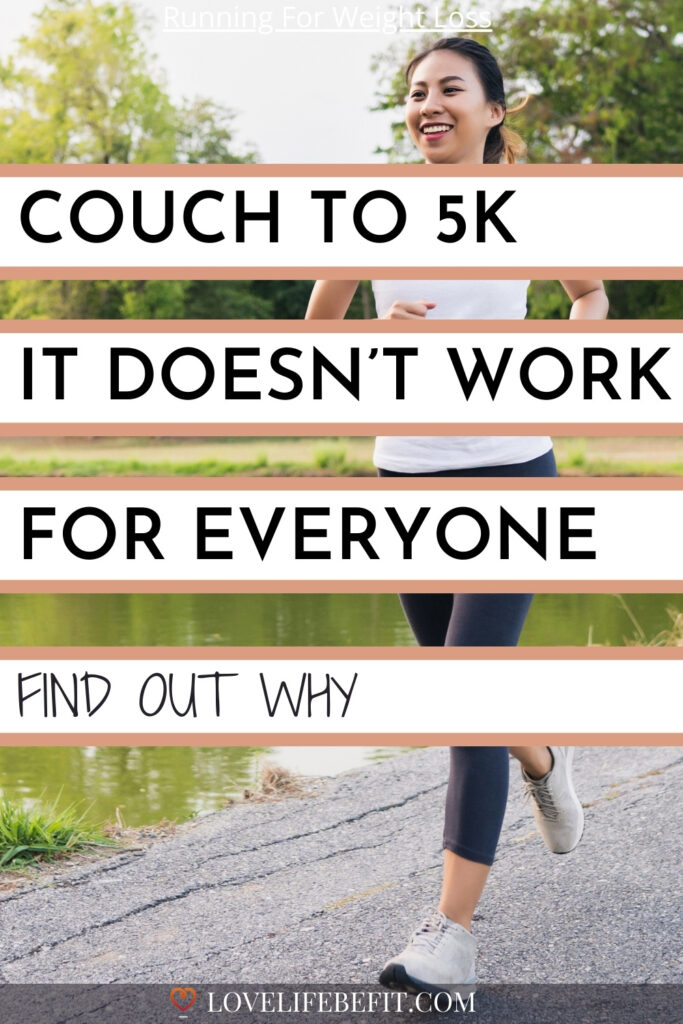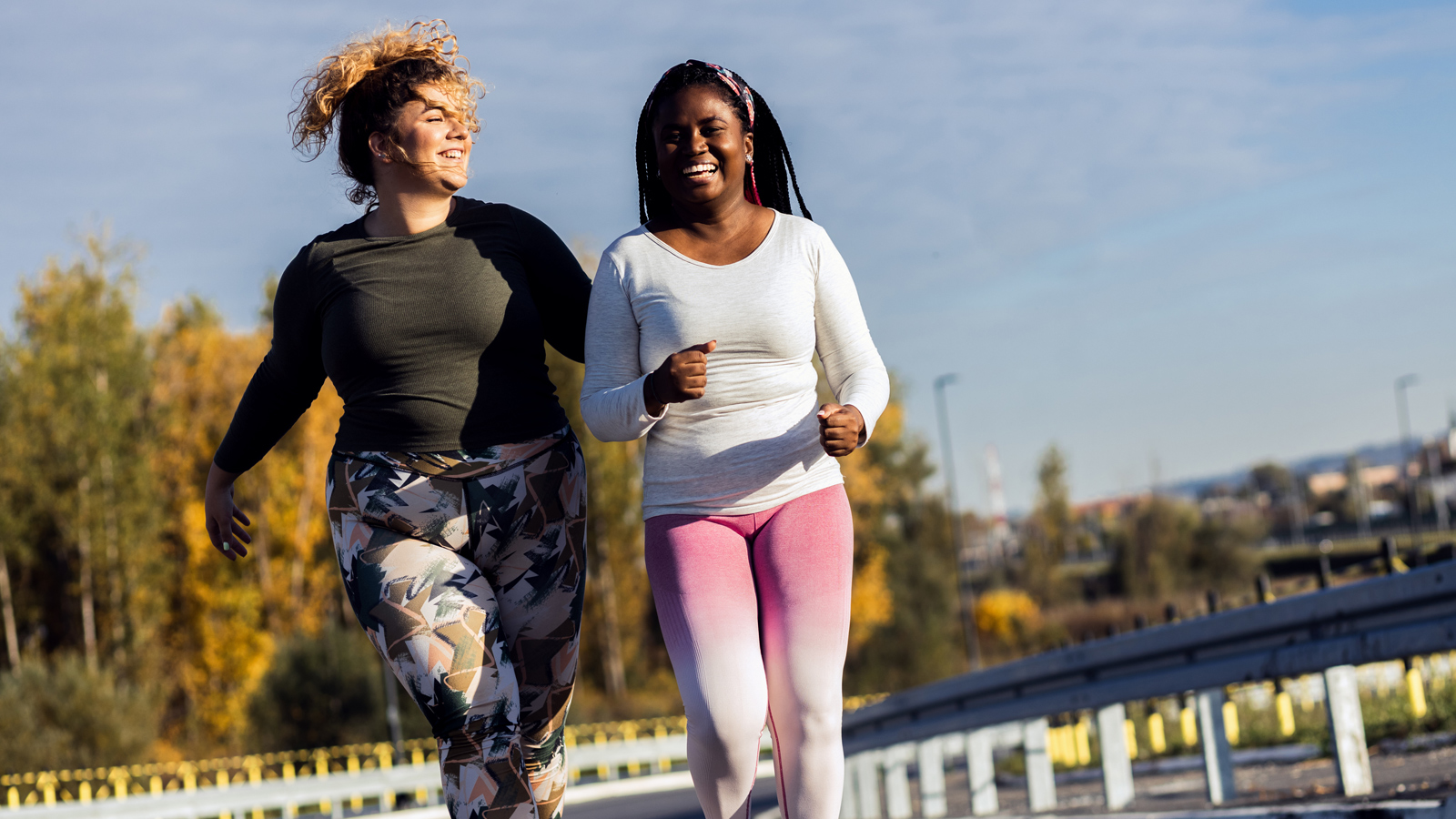Couch To 5K Plan (It Doesn’t Work For Everyone)
It’s a crazy world. The Couch to 5K plan was invented by Josh Clark the founder of a design agency. No sports science degree, no coaching experience, yet he came up with a training program that’s helped millions of people around the world become runners.
The brilliance of the program lies in its slow build-up. It really is a schedule that can turn even the most reluctant runner into a total convert. And get you to the finish line of your first race.
This comprehensive guide covers all your searing questions about Couch to 5K such as how long will the exercise program take, is it good for beginners, can everyone run 5K, and what happens next.

Is Couch To 5K Good For Weight Loss
Most people start the Couch to 5K plan to lose weight. So what is the weight loss on Couch to 5K? What can you expect?
- Couch to 5K is a great program to take you from zero to running 5K in 9 weeks. It’s not a plan for losing weight.
- You will get fitter, but if your diet remains unchanged, you need to run a total distance of 35 miles to lose just one pound of fat.
- Even by week 9, Couch To 5K is only 90 minutes of running per week. For most beginners, that’s less than 9 miles. Not enough to burn one pound of fat.
Does that mean I’m dishing this running plan? Not at all! It’s a great way to start exercising, especially if the last time you ran was years ago when you still wore gym skirts and white ankle socks.
It’s just that it’s going to take more than Couch to 5K to hit your weight loss goals. You need to tackle your diet.
Combine Couch to 5K with a healthy eating plan swopping high fat, high sugar foods for lean protein, whole grains, and heaps of fresh fruit and vegetables.
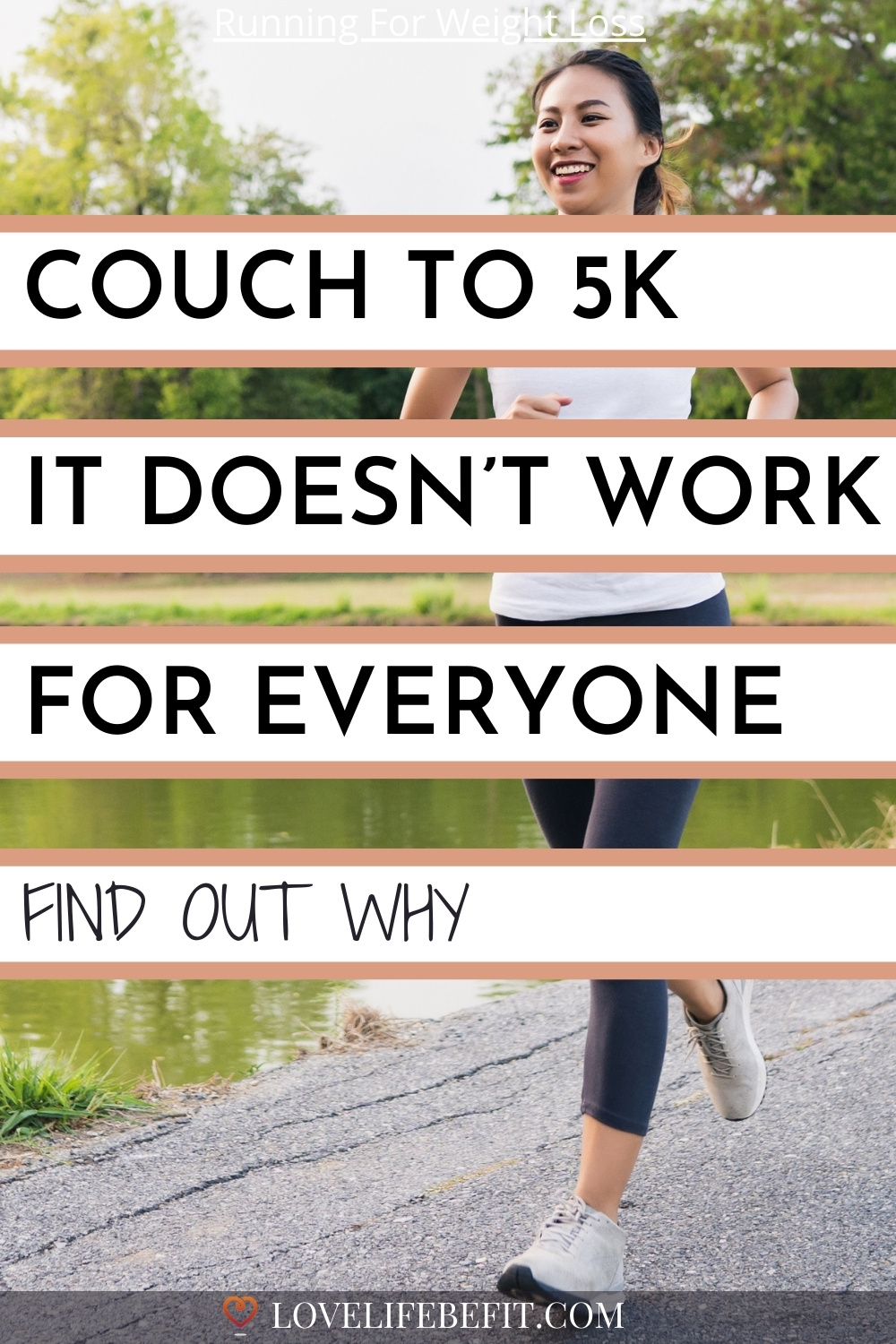
What Is The Couch To 5K Running Plan?
Josh Clark posted the Couch to 5K plan on a blog called Cool Running back in 1996. Sadly the blog no longer exists. The aim was simply to get couch potatoes to take up running.
Often abbreviated to C25K plan, the original running program has been copied and modified by thousands of running blogs. There are 6 and 12-week versions and I’ve included my own Couch to 5K in 6 weeks plan at the end of this post. The original Couch to 5K plan goes from zero to running 5K non-stop in just 9 weeks.
How many miles is 5K? 5K is 5 kilometers – that’s 3.1 miles. It’s a popular race distance and many people follow C25K with the aim of training for their first 5K race.
This 9-week plan is such a successful exercise motivator it’s been adopted by the UK National Health Service – part of their bid to tackle obesity and boost health.
So what’s in the C25K program?
The plan is really simple. Not surprising really when you think about how it came about. Josh Clark just scribbled down the run-walk schedule and gave it that terrific name.
You have to wonder. If he’d called it Run-Walk To 5K Plan would it have been anywhere near as popular?
Yet there’s nothing wrong with simplicity. The power of the schedule is you just have to alternate running and walking for set time periods.
For the first week, you’re alternating 60 seconds of running, (he called it jogging), with 90 seconds of walking for 8 repetitions. That’s just 20 minutes of exercise plus a five-minute warm-up walk completed three times a week.
It’s interval training in its most basic form and there’s nothing wrong with that. Most people instinctively start running this way – I know I did. The walking breaks make it easier to keep going for longer.
Intervals are a terrific way to get better at running and just about all runners who want to get faster will work intervals into their training schedule.
But fair dues, Josh Clark made up a schedule, stuck it on the fledgling internet with a kick-ass name and the rest as they say is history.
How Do I Start Couch To 5K?
The best way if you live in the UK is to download the NHS app. It’s free and it’s going to give you tons of motivation to help you stick to the plan over the next 9 weeks.
For US readers, Active Network has taken over from the original Cool Running blog and you can buy their app for $4.99. A small fee to transform your fitness.
Another popular Couch to 5K app available worldwide is the C25K App by Zen Labs Fitness. There’s a free version with an 8-week program – the first week may be a little ambitious for some people.
It’s almost impossible to find the official Couch to 5K Program in a printed format online – no doubt because Active Network wants you to buy their app! So I’ve created my own version with a few improvements. Just print it out and get started.
Couch To 5K 9-Week Training Plan Printable
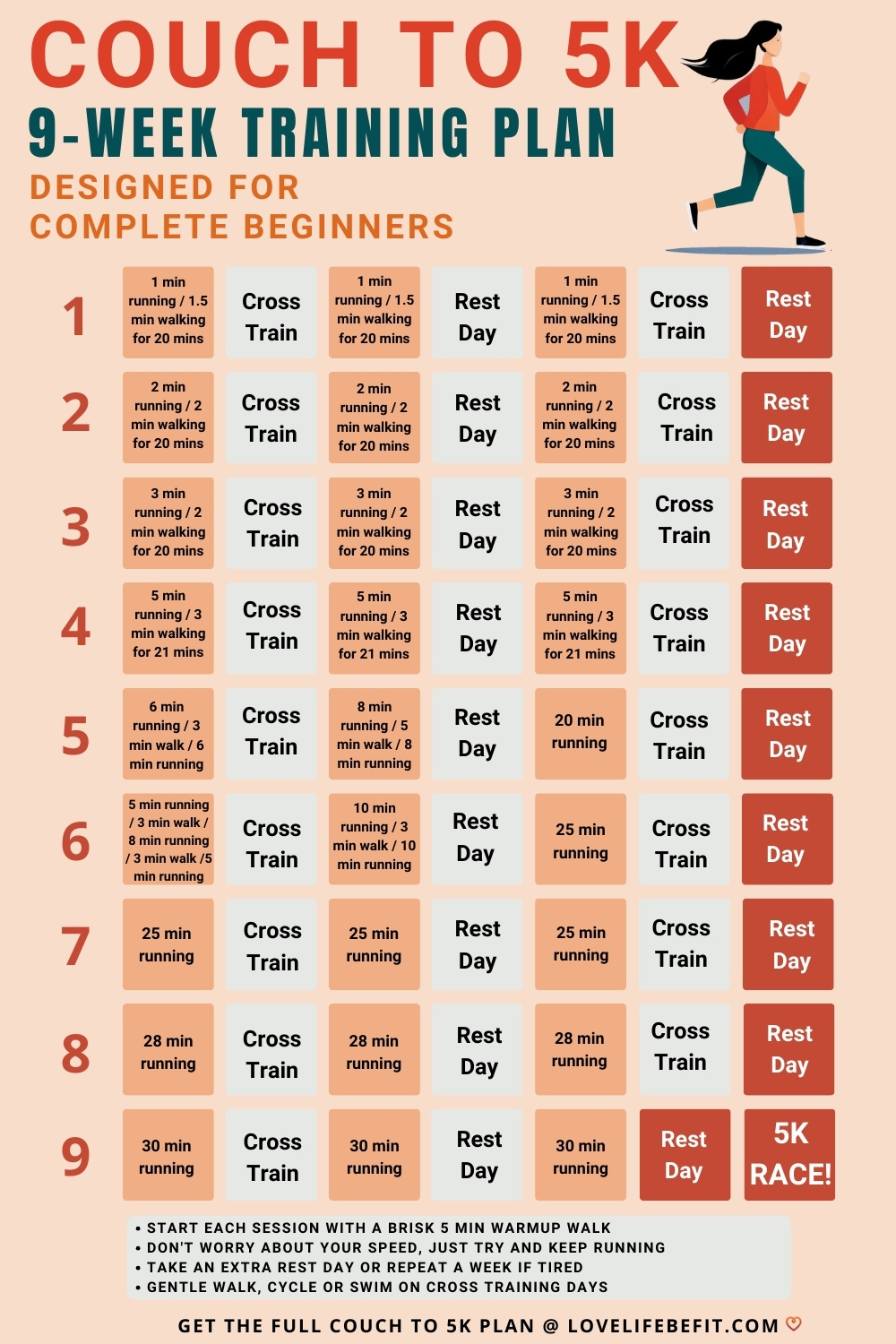
Why Couch To 5K Works
C25K works by slowly building the length of the running intervals and gradually making the walking intervals shorter. Before you know it, you’re running longer and longer intervals and by the end of week 5, you’re running 20 minutes without stopping.
There are workouts for three days of the week so take a rest day between workouts and an extra day off at the end of your week.
It’s best to still be active on most of your rest days but take at least one complete day of rest. Walk or cycle for 20 minutes. Strength training or swimming is also good. Anything that keeps you moving. Try these bodyweight exercises for runners.
The schedule goes from walk-run intervals for the first 6 weeks to running continuously for the last 3 weeks. By that stage, you’ll start to believe in yourself as a runner!

Does Couch To 5K Work For Everyone?
This is the big fat question! Just because this plan works for a lot of people it doesn’t mean it’s going to be everything to everybody. It will depend on your current fitness level.
The problem is not everyone doing C25K is at the same starting point and not everyone has the same goals. It’s like having a sticking plaster that comes in one size only. Know what I mean?
So here are a few reasons why Couch To 5K may not work for you:
1. It’s Just Too Hard
The great strength of the popular Couch To 5K Program is its gradual build-up but you’re still launching into running in the first week. Those intervals of 60 seconds run, 90 seconds walk will just be too hard for some people.
If you’re carrying a lot of extra weight or you haven’t exercised in years, don’t try and run. It’s just a shortcut to getting disillusioned or injured or both. There’s no need for really out-of-shape people to start their exercise plans with running. There’s a saying don’t run before you can walk!
Some people will be better off starting with a power walking program. You can switch out the running sections of Couch To 5K with fast-paced walking. Or just build up the length of daily walks until you can walk 10,000 steps a day. You may find my Walking for Weight Loss Challenge is a good place to start. Or try our 5K Walking Plan for Beginners.
2. The Build Up Is Too Fast
If you haven’t exercised for a long time it’s better to take a couple of weeks preparing to start the Couch To 5K Program. Go out for fast-paced walks and try a little easy running. That way, when you start the program, it won’t be such a shock to your body.
Be prepared to repeat weeks if you’re not ready to move on. The program should be doable not demoralizing. If you find a session is too hard drop back a week or switch out some of the run sections for walking.
There isn’t a one-size-fits-all when it comes to running. As long as you’re making progress, running further or faster, feel free to adapt the program. The amount of time it takes to complete C25K is up to you. 9 weeks to 5K or 18 weeks to 5K. It doesn’t matter. Complete the plan at your own pace.
The aim is to get fitter and build a lifelong habit of exercise.
3. It’s Just Too Easy
Yes, you read that right. It may not be fair but not everyone’s starting at the same fitness level.
Some people will find Couch To 5K too easy – especially if they’ve run in the past, walk regularly, or complete other types of fitness workouts.
One solution is to skip ahead with the program or find a more demanding training plan. Try following the Couch to 5K in 6 weeks plan below. If it gets too much, just repeat a week. Or if you want a big challenge, try my Couch to Half Marathon plan.
Another option is to set yourself a target such as running 5 miles a day and build up to that level slowly. Maybe alternate walk one mile, run one mile for the first few weeks.
Listen to your body and make sure you don’t overdo it. Getting injured will just send you right back to square one.
4. You Don’t Lose Any Weight
A lot of beginner runners start off with the goal of losing weight. Some of them fall in love with running and keep it up anyway, some lose weight and for some weight loss just doesn’t happen.
Surely everyone should lose weight running? Sadly no. The problem is exercise is only one part of the equation. If you want to lose weight you have to watch what you eat.
You need to run 35 miles to burn just one pound of fat. Even by week 9, the C25K Plan is only 90 minutes of running per week. For most beginners, that’s less than 9 miles.
There are a lot of different factors at play here, your weight, gender, and metabolism. Couch To 5K will help you lose weight – but you still need to control the calories you eat and follow a healthy diet.
Unless you have a very high metabolism – think growing teenager – you can’t eat everything in sight and expect to lose weight. This is a problem because running can make you really hungry!
You can read more about how to lose weight running but the best advice is:
- hydrate fully after your run
- swap sugary treats and high-fat foods for fruit, vegetables, and lean protein.
5. It’s Not Varied Enough
The last 3 weeks of Couch To 5K are just steady running. The distances get slightly further but you’re not varying your training.
Maybe you’re running these sessions harder and faster, but I suspect most runners are just running at a steady slow pace.
Now there’s nothing wrong with that, especially for beginner runners, but it would be good to add some fartlek sessions, that’s the Swedish word for speed play.
Think of it as free-form interval training where you run harder for a minute or two then back off to an easier pace. Keep repeating, tuning into your body to know when to push and when to ease up.
Try making one of your weekly runs a fartlek session in those last three weeks of the Program. It’s a good way to up the intensity and makes sure your running is still improving.
6. There Are No Strength Sessions
Building strength is important to avoid injury when you’re a beginner runner. It’s also a shortcut to getting the body you always wanted.
These essential strength exercises work well. Yoga for runners is also a great way to build strength and avoid muscle imbalance. Try and make time for one strength session every week. You’ll soon start to see the benefits.

Couch To 5K in 6 Weeks Plan
There are various training plans for C25K. This is my suggestion for going from Couch to 5K in 6 weeks. I’ve included it for people with a history of running or for those who are active in other sports and feel the original plan is too slow. It could also work for runners returning to fitness after an injury layoff.
To keep things easy and so that the only equipment you need is a watch, (and a good pair of running shoes), this 6 Week 5K Training Plan is based on time spent exercising rather than distance.
Most new runners will take 30 to 40 minutes for a 5K so this training plan is based on building up to running continuously for 30 minutes.
As a rule of thumb, most people can complete races 2.5 times their regular training run. So if you’re finding it relatively easy to run for 12-15 minutes plus by the end of the 6 weeks, you should manage to get around 5K race without stopping.
Each training session starts with a 5-minute warmup walk for the first week. After the first week, you may feel able to break into an easy run during your 5-minute warmup.
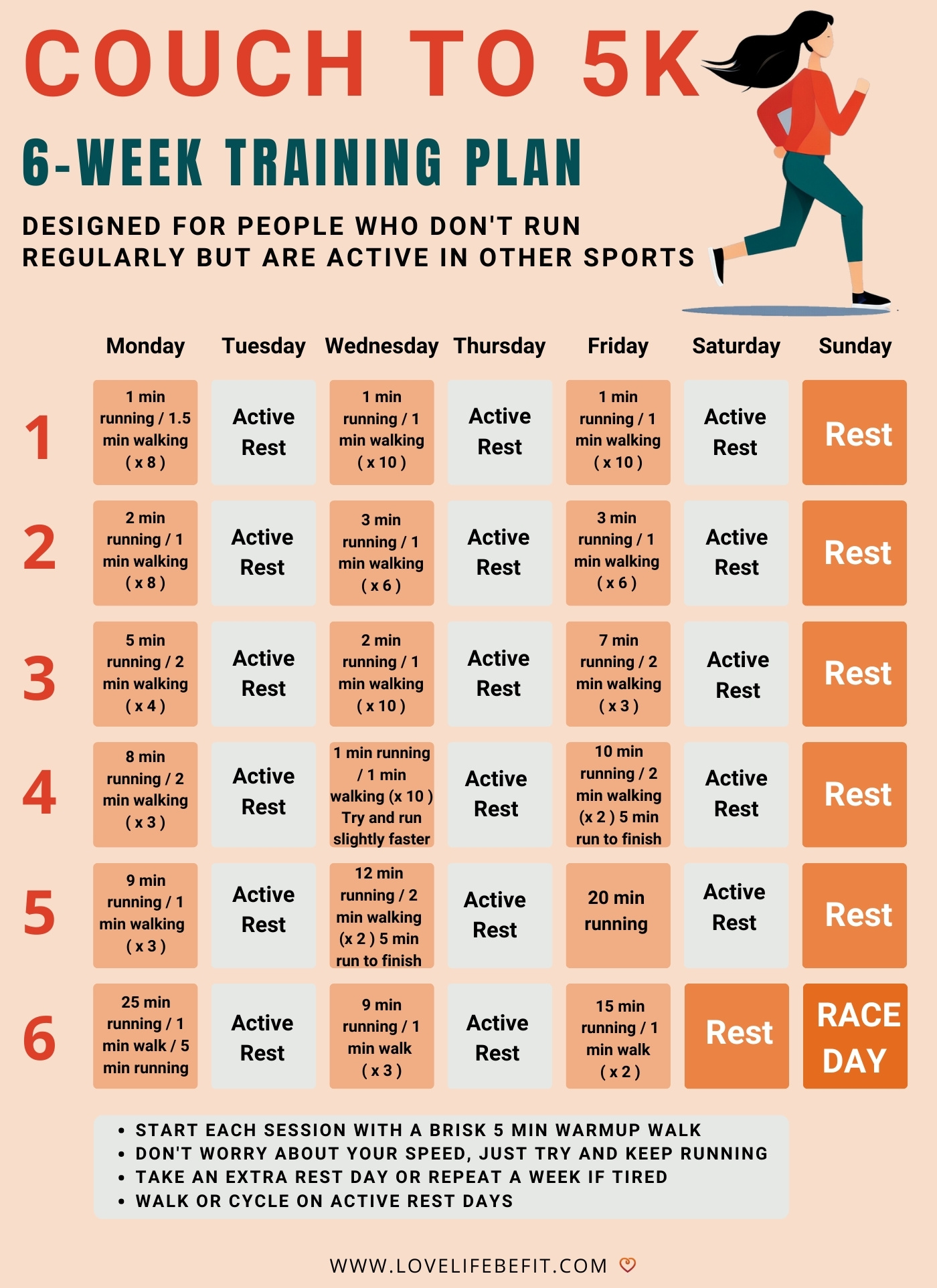
Week 1
- Day 1: Brisk five-minute warmup walk, then do 8 repetitions of the following: 60 seconds of running, 90 seconds of walking.
- Day 2: Active rest. Make sure you walk during the day or cross-train.
- Day 3: Brisk five-minute warmup walk, then do 10 repetitions of the following: 60 seconds of running, 60 seconds of walking.
- Day 4: Active rest.
- Day 5: Brisk five-minute warmup walk, then do 10 repetitions of the following: 60 seconds of running, 60 seconds of walking.
- Day 6: Active rest.
- Day 7: REST.
Week 2
- Day 1: Warm-up for five minutes, then do 8 repetitions of 2 minutes running, 1 minute walking.
- Day 2: Active rest.
- Day 3: Warm-up for five minutes, then do 6 repetitions of 3 minutes running, 1 minute walking.
- Day 4: Active rest.
- Day 5: Warm-up for five minutes, then do 6 repetitions of 3 minutes running, 1 minute walking.
- Day 6: Active rest.
- Day 7: REST.
Week 3
- Day 1: Warm-up for five minutes, then do 4 repetitions of 5 minutes running, 2 minutes walking.
- Day 2: Active rest.
- Day 3: Warm-up for five minutes, then do 10 repetitions of 2 minutes running, 1 minute walking.
- Day 4: Active rest.
- Day 5: Warm-up for five minutes, then do 3 repetitions of 7 minutes running, 2 minutes walking.
- Day 6: Active rest.
- Day 7: REST.
Week 4
- Day 1: Warm-up for five minutes, then do 3 repetitions of 8 minutes running, 2 minutes walking.
- Day 2: Active rest.
- Day 3: Warm-up for five minutes, then do 10 repetitions of 1 minute running, 1 minute walking. Try and run at a slightly faster pace.
- Day 4: Active rest.
- Day 5: Warm-up for five minutes, then do 2 repetitions of 10 minutes running, 2 minutes walking. Finish with 5 minutes running.
- Day 6: Active rest.
- Day 7: REST.
Week 5
- Day 1: Warm-up for five minutes, then do 3 repetitions of 9 minutes running, 1 minute walking.
- Day 2: Active rest.
- Day 3: Warm-up for five minutes, then do 2 repetitions of 12 minutes running, 2 minutes walking. Finish with 5 minutes running.
- Day 4: Active rest.
- Day 5: Warm-up for five minutes, then run continuously for 20 minutes.
- Day 6: Active rest.
- Day 7: REST.
Week 6
- Day 1: Warm-up five minutes, then run continuously for 25 minutes. Walk for 1 minute. Finish with 5 minutes running.
- Day 2: Active rest.
- Day 3: Warm-up five minutes, then do 3 repetitions of 9 minutes running, 1 minute walking.
- Day 4: Active rest.
- Day 5: Warm-up five minutes, then do 2 repetitions of 15 minutes running, 1 minute walking.
- Day 6: REST.
- Day 7: 5K RACE!
On race day you’ll be all fired up and should manage to run for at least 20 minutes without taking a break. Most people will manage to get to the end of the race without stopping but there’s no shame in taking a walking break if you need one.
A Few Other Things You Need To Think About
Before you launch into your fitness journey, here are a few pitfalls you need to avoid:
Getting Injured
There’s always a high risk of injury for beginning runners. Most injuries, such as shin splints and plantar fasciitis are from doing too much too soon. So try not to get carried away. For absolute beginners, less is more.
If you’re a complete couch potato with no history of exercising, take the full nine weeks or longer to complete the program. Even if you’re already fit but new to running, don’t suddenly sign up for a half marathon. Build your training slowly!
Running Form
Learning how to run properly can help runners avoid injury. Landing with your feet under your body instead of overstriding, maintaining a good cadence, and keeping upright can make a big difference to how you run. Find out more about running form.
Running Gear
You don’t need a lot of equipment to go running but it’s essential to invest in some good running shoes and most people prefer to run in specific running clothing. If you’re overweight you may need shoes with extra support.
Giving Up Because Running Feels Too Hard
I’m a great believer in finding a fitness activity you enjoy. Just because I love running doesn’t mean you will. However, I don’t think you should give up before giving running a proper try. Follow these Couch to 5K tips to help you breathe while running and make running feel easier.
What Comes Next After Couch To 5K?
Hopefully, Couch To 5K will make you fall in love with running and you’ll feel the benefits of following a healthy lifestyle. To enjoy going for a good run. And at the end of the program, aim to complete your first 5K race. It’s a great goal to aim for. Find a local fun run or road race where they’ll be lots of similar beginner runners and friendly support to cheer you over the finish line.
It’s fun and exciting to be running with other people and you’ll feel a terrific sense of achievement. Once you’ve got your first medal around your neck, what happens next?
Parkrun is a fantastic movement that started in the UK providing free-to-enter timed 5K runs. They take place every Saturday morning and there’s now an event in almost every town throughout the UK.
It’s a great way to keep up your newfound enthusiasm for running. The Parkrun movement is spreading worldwide with a rapidly growing number of US locations. Find out if there’s a venue near you.
Couch To 5K is just the first step on your running journey. As soon as you’ve completed your first 5K race set your next fitness goal. Keep up your fitness momentum! You can even go straight from Couch To 10K with our training plans!
Find a running club or group of friends and set new challenges. You can start training for a 10K, a half marathon or try and work on your speed. Maybe you’ll even fall in love with trail running…
Related post: Couch To 5K Treadmill Training Plan
Running is a huge part of my life. It’s taken me on adventures all over the world and I’ve made really close running friends. Good cardio and keeping in shape are just added bonuses.
I made the effort to take up running when I was just 15, alternating walking and running in the local woods where no one could see me. It was a good way to start running without getting tired. At times it seemed it would never get any easier, but it does and the rewards are definitely worth it.

Running 101 Training Guides & Walking Schedules
5K Training Plans
- Couch To 5K Beginner Training Plan
- 12 Week 5K Training Plan
- 10 Week 5K Training Plan
- 8 Week 5K Training Plan
- 6 Week 5K Training Plan
- 4 Week 5K Training Plan
- 5K Training Plan Intermediate
